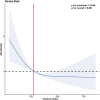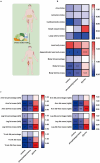Choline consumption reduces CVD risk via body composition modification
- PMID: 38997295
- PMCID: PMC11245612
- DOI: 10.1038/s41598-024-66039-4
Choline consumption reduces CVD risk via body composition modification
Abstract
Despite extensive research on the relationship between choline and cardiovascular disease (CVD), conflicting findings have been reported. We aim to investigate the relationship between choline and CVD. Our analysis screened a retrospective cohort study of 14,663 participants from the National Health and Nutrition Examination Survey conducted between 2013 and 2018. Propensity score matching and restricted cubic splines was used to access the association between choline intake and the risk of CVD. A two-sample Mendelian randomization (MR) analysis was conducted to examine the potential causality. Additionally, sets of single cell RNA-sequencing data were extracted and analyzed, in order to explore the role of choline metabolism pathway in the progression and severity of the CVD and the underlying potential mechanisms involved. The adjusted odds ratios and 95% confidence intervals for stroke were 0.72 (0.53-0.98; p = 0.035) for quartile 3 and 0.54 (0.39-0.75; p < 0.001) for quartile 4. A stratified analysis revealed that the relationship between choline intake and stroke varied among different body mass index and waist circumference groups. The results of MR analysis showed that choline and phosphatidylcholine had a predominantly negative causal effect on fat percentage, fat mass, and fat-free mass, while glycine had opposite effects. Results from bioinformatics analysis revealed that alterations in the choline metabolism pathway following stroke may be associated with the prognosis. Our study indicated that the consumption of an appropriate quantity of choline in the diet may help to protect against CVD and the effect may be choline-mediated, resulting in a healthier body composition. Furthermore, the regulation of the choline metabolism pathway following stroke may be a promising therapeutic target.
© 2024. The Author(s).
Conflict of interest statement
The authors declare no competing interests.
Figures






Similar articles
-
Effects of obesity-related anthropometric indices and body composition on erectile dysfunction mediated by coronary artery disease: A Mendelian randomization study.Andrology. 2024 Jan;12(1):75-86. doi: 10.1111/andr.13443. Epub 2023 May 4. Andrology. 2024. PMID: 37082877
-
Dietary choline intake and health outcomes in U.S. adults: exploring the impact on cardiovascular disease, cancer prevalence, and all-cause mortality.J Health Popul Nutr. 2024 May 6;43(1):59. doi: 10.1186/s41043-024-00528-0. J Health Popul Nutr. 2024. PMID: 38711145 Free PMC article.
-
Association between Dietary Choline Intake and Cardiovascular Diseases: National Health and Nutrition Examination Survey 2011-2016.Nutrients. 2023 Sep 18;15(18):4036. doi: 10.3390/nu15184036. Nutrients. 2023. PMID: 37764819 Free PMC article.
-
Dietary choline is positively related to overall and cause-specific mortality: results from individuals of the National Health and Nutrition Examination Survey and pooling prospective data.Br J Nutr. 2019 Dec 14;122(11):1262-1270. doi: 10.1017/S0007114519001065. Epub 2019 Nov 6. Br J Nutr. 2019. PMID: 31288869
-
[Simple obesity in children. A study on the role of nutritional factors].Med Wieku Rozwoj. 2006 Jan-Mar;10(1):3-191. Med Wieku Rozwoj. 2006. PMID: 16733288 Review. Polish.
References
MeSH terms
Substances
Grants and funding
LinkOut - more resources
Full Text Sources

